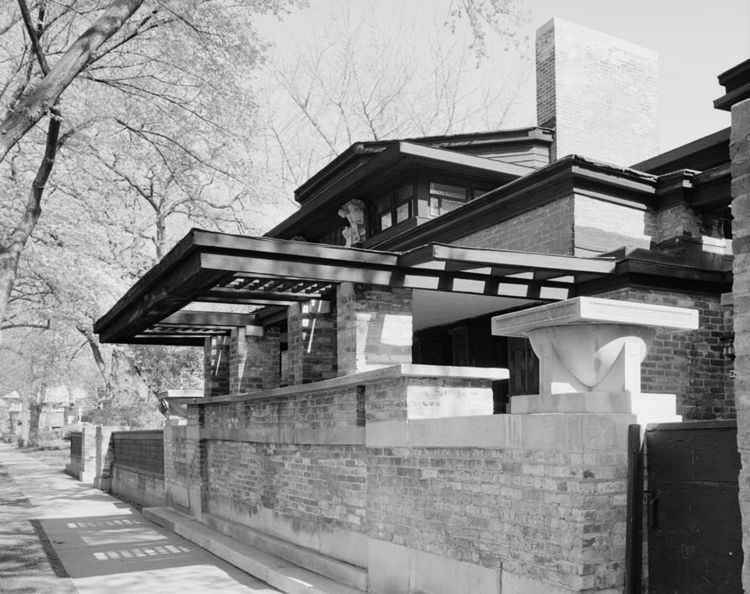Built 1889 Added to NRHP September 14, 1972 Area 1,619 m² | NRHP Reference # 72000456 Designated NHL January 7, 1976 | |
 | ||
Address 951 Chicago Ave, Oak Park, IL 60302, USA Architectural style Shingle style architecture Hours Open today · 9AM–5PMThursday9AM–5PMFriday9AM–5PMSaturday9AM–5PMSunday9AM–5PMMonday9AM–5PMTuesday9AM–5PMWednesday9AM–5PM Similar Darwin D Martin House, Robie House, Unity Temple, Frank Lloyd Wright–Pr, Taliesin | ||
The Frank Lloyd Wright Home and Studio is a historic house designed by renowned architect Frank Lloyd Wright. Located at 951 Chicago Avenue in Oak Park, Illinois, the house has been restored by the Frank Lloyd Wright Preservation Trust to its appearance in 1909, the last year Frank Lloyd Wright lived there with his family. Frank Lloyd Wright purchased the property and built the home in 1889 with a $5,000 loan from his employer Louis Sullivan. He was 22 at the time, and newly wed to Catherine Tobin. The Wrights raised six children in the home. The building was listed on the National Register of Historic Places in 1972 and declared a National Historic Landmark four years later.
Contents
Frank lloyd wright home and studio
History
The original 1889 structure was quite small. The home was extensively remodeled in 1895, when among other changes the kitchen was enlarged and converted to a dining room, the upstairs nursery was expanded and converted for use as Catherine's dayroom, and the Children's Playroom and a new kitchen were added to the back of the house. A second major addition was made in 1898, when the Studio and Connecting Corridor were built. In the Studio, Frank Lloyd Wright and associated architects like Walter Burley Griffin and sculptor Richard Bock advanced the Prairie School of Architecture and designed many notable structures, including the Robie House, Unity Temple, the Laura Gale home, and the Larkin building. After 1909, the Studio was converted into a residence for his wife and the younger children. Later on, the Home and Studio became an apartment building. In the 1960s it fell into disrepair as the owners began to neglect the property due to financial problems. The longtime roofing company entrusted by Frank Lloyd Wright, Oak Park-based Tuscher Roofing, took control of the property. In 1974, the structure was handed over to the National Trust for Historic Preservation and the 13-year restoration began.
The Home and Studio was declared a National Historic Landmark in 1976, and has received the American Institute of Architects' National Honor Award. It is owned by the National Trust for Historic Preservation, and has been restored, maintained, and operated as a museum by the The Frank Lloyd Wright Preservation Trust. Every May, the Frank Lloyd Wright Preservation Trust hosts a housewalk of the home and studio and various private homes.
Frank Lloyd Wright's Home and Studio is located in one of three historic districts of Oak Park, Illinois. It is specifically found in the Frank Lloyd Wright-Prairie School of Architecture Historic District, which includes 27 Wright-designed structures as well as other historical and architecturally significant buildings.
The Home and Studio Museum Shop is currently located in the East end of the building, and carries most of the extensive Frank Lloyd Wright, Prairie and Arts & Crafts related products available at ShopWright.org.
Sculptures
Most of the sculptures on the exterior of the Home and studio were designed by Wright's friend and collaborator, Richard Bock. These include the two boulder figures flanking the entrance of the studio, which features a man crouching and breaking free from the ground beneath him. Bock also designed the stork capitals on the exterior loggia of the studio. The capitals signifies the tree of life, the book of knowledge, an architectural scroll, and two storks full of wisdom and fertility.
Wright's home included many sculptures on the interior which added to and contrasted with the anti-Victorian decor. These objects include a frieze from the Pergamon Altar and several sizes of Winged Victory of Samothrace as well as a bust of Beethoven.
